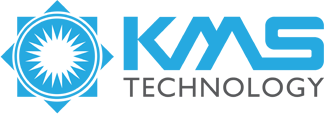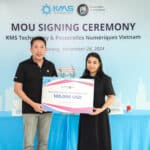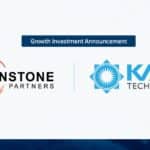Outsourcing: Josh Lieberman, Co-Founder of KMS Technology Atlanta and Ho Chi Minh City

Founded in 2009, KMS Technology partners with clients that range from startups to Fortune 500 companies to provide software development services such as research and development, product innovation and management, application management, testing, support, professional services, and staff augmentation.
Sramana Mitra: Hi, Josh. Let’s start with some background about you and KMS Technology.
Josh Lieberman: I’ll start with the company that we had prior KMS because I think a lot of our history leads into how we formed KMS to be what it is today. Trade relations with Vietnam opened up in 2005. My partner, Vu Lam, is in Vietnam as we speak. He and I are partners in KMS. Vu started a company with a couple of friends called Paragon Solutions. Their mission with Paragon Solutions was to develop the outsourcing model in Vietnam, not just India. So, Vu moved to Vietnam, started an offshore development center in conjunction with the university over there. He and his friends bootstrapped Paragon Solutions.
A few years after that, they brought on some capital funding. In 1999, as the dot-com bubble was still expanding, a new management team was brought on by the VCs, and I was one of those people brought in to upgrade the business. The bubble burst. We fought through the years, and Vu and I were part of the management team and worked together on that. We turned that company around, made it cash flow positive, sold it to First Consulting Group, which was a health care consulting firm. And then FCG sold to CSC.
With all of the funding from those companies, we built Paragon Solutions to be about a $30 million business. We have 600 people in Bangalore, India, and 600 people in Ho Chi Minh City, Vietnam, and about 50 people here in the United States. Vu and I didn’t want to be part of a big company, so in 2009, he called me and said, “Hey, do you want to make another run at this ourselves?” We bootstrapped KMS at the beginning of 2009. He began in January. I joined him in October.
When we started KMS, our plan was to build a successful outsourcing business. We also wanted to leverage the engine that we’d built in Vietnam to spin-off product software companies as well. From 2009 through 2012, we’re up to more than 300 people in Ho Chi Minh City. We’ll do over $10 million this year in revenue. We were rated the fourth fastest growing company in Atlanta in 2011.
SM: So, you have headquarters in Atlanta, and Ho Chi Minh City is the outsourcing team?
JL: Yes. We also have an office in Dublin, California, in the Bay Area. That’s where Vu lives.
SM: Talk to me about the business. $10 million worth of what?
JL: We have a very specialized focus, and it’s working with software product companies, technology companies. We don’t go out and try to sell to the big brick-and-mortar companies and the airline or retail. Our specialization in our prior company and in KMS as well is to go in and partner with an ISV or a startup or software product company and take over and/or supplement a lot of that company’s software development, maintenance, QA, or support functions. It’s traditional IT consulting, like an Infosys started out with or Wipro. It’s just being done out of Vietnam, and it’s being done for small, midsize and some large software product companies.
SM: That category is called outsourced product development. We’ve done huge stories about Persistent, Symphony, Globant, Global Logic, all of these companies that are larger competitors in your category.
JL: Correct. I’ve competed with those companies over the years. I haven’t competed with them since we started KMS, but I am familiar with Symphony and Persistent and the rest of them.
Sramana Mitra: Now we understand the positioning of the company. Tell us, what is the unique selling proposition (USP)? Within outsourced product development, what is your company’s USP? How do you differentiate, and what do you pitch that is compelling to your customers?
Josh Lieberman: Up to now we have had zero sales or marketing. So, in terms of having a USP, we really haven’t had to have one. Most of our customers have called us and said, “Hey, I’ve heard about you. I’ve worked with you in the past. I know you guys are good guys, and I want to work with you again.” In terms of going through that RFP process, putting together our USP, we haven’t had to do that at all thus far. We do plan to get a bit more aggressive from a sales and marketing perspective and are looking forward to getting into more competitive situations.
In terms of what our specific USP is, to answer your question more directly, it’s a couple of things. First and foremost, we’re out of Vietnam. All of the companies you mentioned are predominantly out of India. And while they are larger than KMS, in the grand scheme of India, they’re still not very large players. They’re medium sized or small fish in a big pond. We’re a very large, colorful, well-known fish in a small pond in Vietnam. So, the first USP or differentiator is that while the talent pool in Vietnam is smaller than what it is in India, we are able to attract the best talent in the country. I don’t care how big your pond is, if you can attract the best talent in the country, and you need only as many people as are needed for an engagement, your probability of success is better than if you have a mix of B players, C players, and A players.
SM: You have 600 people in Vietnam, and you are one of the more prominent employers in Vietnam. That’s your primary USP in that sense.
JL: Yes, that’s our first USP. My partner Vu pioneered outsourcing in Vietnam, so he has a strong personal brand. Second, in our world, you don’t want to talk about price too much, but one of the primary reasons people do outsourced product development is because they want to lower their price points. They want more flexibility and such. Because we’re in Vietnam, our prices are significantly lower than India’s, and even more so than what you would get out of Argentina. That is for a few reasons. One, we’re in Vietnam. Second, from the day we started the company, we knew one of our value propositions was going to be price. That goes hand in hand with being in Vietnam.
SM: What is the price comparison with India? How much cheaper are you?
JL: Our rates, on average, are about $6 less per hour than India’s and at least $12 less than rates in Argentina.
SM: That sounds about right. But India is a very big country. One major trend that we are seeing in India is the second-tier and third-tier city trend. If you’re competing with Bangalore, you’ll see one rate. If you go to the second-tier or third-tier cities, you’ll see a rate that is comparable to what you just quoted or even cheaper. India, as you said, is very big. Bangalore is out of control from an attrition point of view. But there are so many other regions.
MphasiS – you may have heard of it – is doing a large amount of work from these second-tier and third-tier cities. Granted, that’s mostly BPO work, not OPD work, but I think the dynamics are similar.
JL: Yes. I think the challenge, when you go out to the tier-three cities – because I’ve done due diligence on those over the years – is that your talent pool, your depth and breadth of talent, isn’t the same as in Bangalore.
SM: But, you know, there are several cities in India that are less competitive with deep talent pools. Calcutta, for instance, is not as competitive and does not have as high an attrition rate as Bangalore or New Delhi. And the rates are somewhat lower. Your point is well taken, that price is something that you can compete with. I think the real issue is more the competition for talent than the price.
JL: Yes. That was my next point. Our attrition rate is below 5%.
Sramana Mitra: That’s the real winning story.
Josh Lieberman: Absolutely.
SM: In India, no matter where you are … in the big cities, you’re looking at 30% attrition. In the smaller cities, you’re looking at 20% attrition. That’s the real problem. If you’re looking at below 5% attrition, that is the real winning story.
JL: Absolutely. It’s funny, I’ve been formulating in my mind that I haven’t built the model yet, but I think there’s a model that needs to be built that factors in the true cost of attrition in an outsourcing relationship. There is a real cost there. I think the other things that we do that are important are first, not only do we not have attrition in the company, but also within an account, we’re ethical and loyal people. We build deep relationships with our clients. And when we have people on an account, we don’t do bait and switch. We don’t move people around. Our people build long-standing relationships both from a personal standpoint and from a technical depth standpoint with our clients. They remain engaged with our clients for years on end.
SM: You can only do that with a low-attrition scenario. With a high-attrition scenario, that’s just not viable.
JL: Exactly.
SM: How many clients do you have that add up to the $10 million in revenue?
JL: We have 17 clients right now.
SM: On average, how big are the teams that each client is using on your end?
JL: I categorize our clients into three tiers. We work with a handful of venture-backed early stage companies. I usually have a handful of people on the team – three, five, six people, very small. Our sweet spot is between 10 and 30 people. Those are ISVs doing between $10 million and $100 million a year in revenue. Then we have a handful of clients where we have 50 people or more working as well.
SM: Are you at liberty to discuss some of the specific clients and the kinds of products you’re building?
JL: Yes, certainly.
SM: Why don’t you talk about some example clients so that you can discuss what kinds of products you’re building in Vietnam?
JL: I’ll give you three different examples. One is a client out of Petaluma, California, by the name of Market Lives. Market Lives was working with an Indian firm and heard that their CEO met, through one of the CEO roundtables, the CEO of one of our other clients. We got a call from the CEO of Market Lives, and he said, “Hey, I heard you guys do good work, and you’re cheaper than my current provider out of India. I’d like to talk with you.” We talked with him and he gave us a shot at a small project. Market Lives is actually our largest client. I believe we have around 60 people working for that client right now. We own the majority of Market Lives’ support function. We do product development and R&D work for Market Lives as well.
SM: What does the company do?
JL: Market Lives is an e-commerce platform company. So, Armani Exchange, Warner Brothers, and a lot of other retailers use Market Lives’ platform or software to private label it, put their SKUs in and connect with Amazon, sell products online, and so on. We came in and blew out every productivity metric, every quality metric from the other company that Market Lives was working with, and the team has grown rapidly over the past couple of years. That’s one example of a client. We do a lot of different things for Market Lives.
Another example of a client is a company called Invivo Data out of Pittsburgh, Pennsylvania. This company announced in July 2012 that had been bought by a private equity group. Invivo Data provides handheld devices for people during clinical trials for a pharmaceutical company. As somebody’s going through a clinical trial with a pharmaceutical company, he puts his results in the Invivo Data handheld device, which Invivo aggregates and sends back to the pharmaceutical company. Invivo Data was working with another offshore company, heard about us, asked us to come in and talk about how we could do better what the other offshore company was doing. In this case, it’s a pure QA outsourcing deal. So, Invivo has outsourced its QC function to us. We’ve got a team of 30 or so people in Vietnam. We own Invivo’s entire QC function in this particular case. Once again, we were able to dramatically improve [things] and help Invivo Data to be more successful with its clients.
A third client is a company called Geronimo.com. Geronimo is a company out of Atlanta, Georgia, that was founded by a guy who sold a company he had founded to Comcast. It was called Last-Minute Tee Times. He had done very well for himself. It was about having excess capacity on golf courses and making that available to golfers. In this case, what he’s done is for people who have vacation homes. How do we take those vacation homes and unleash the excess capacity to support charitable organizations? I can donate my home, and certain proceeds of that rental period go to a charity. We believed in what he was doing because we’re an altruistic company. We do a lot of charitable work in addition to what we’re doing for him. We’ve partnered with him and taken an equity stake in the company as well as donated services to him. We have, I believe, five people in Vietnam who work directly with the founder in an agile model and have built and launched that company successfully with him.
The other thing I would comment on that is unique about us is if I look at Market Lives, I think we have three or four people on site and around 60 offshore. With Invivo Data, we have two onsite, two onshore and 30 offshore. For the blend of onshore to offshore, the industry standard, I believe, is somewhere between 20% and 30%. Ours is significantly lower than that in most cases. A core reason for that is when we founded the company, we tried to ensure we had the talent in place in Vietnam who could own relationships with clients in a consultative manner. We didn’t need that overhead in the United States to help be the buffer and manage things for the clients.








